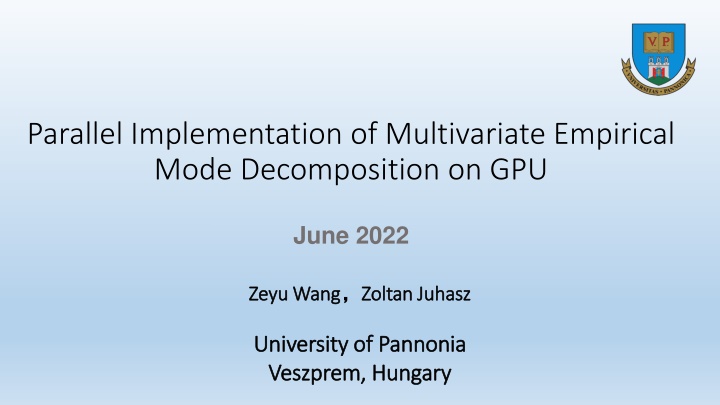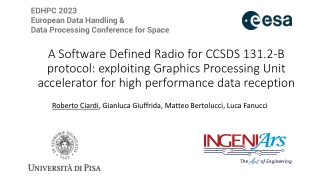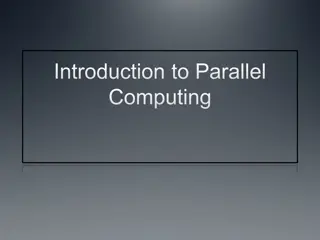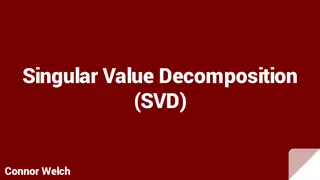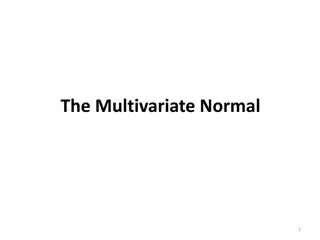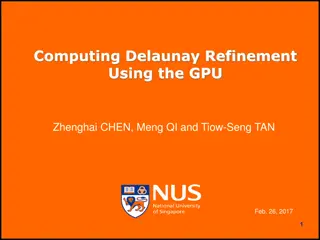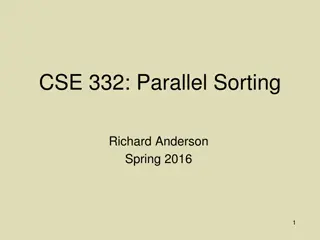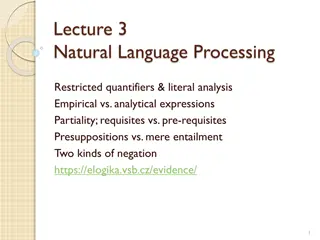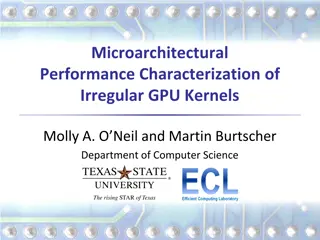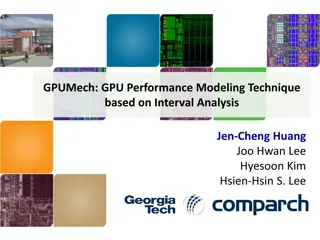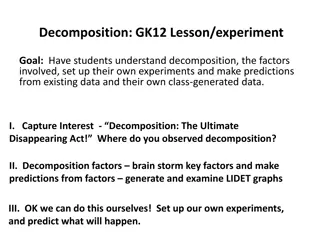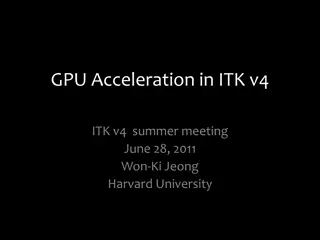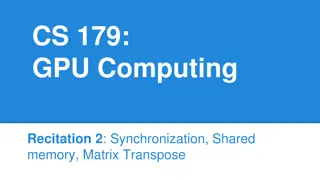Parallel Implementation of Multivariate Empirical Mode Decomposition on GPU
Empirical Mode Decomposition (EMD) is a signal processing technique used for separating different oscillation modes in a time series signal. This paper explores the parallel implementation of Multivariate Empirical Mode Decomposition (MEMD) on GPU, discussing numerical steps, implementation details, and performance analysis. The study focuses on utilizing the computational power of GPU to enhance the efficiency of MEMD, a method that involves processing multivariate envelopes and direction vectors. Future works include further optimizing the parallel implementation for improved performance.
Download Presentation

Please find below an Image/Link to download the presentation.
The content on the website is provided AS IS for your information and personal use only. It may not be sold, licensed, or shared on other websites without obtaining consent from the author.If you encounter any issues during the download, it is possible that the publisher has removed the file from their server.
You are allowed to download the files provided on this website for personal or commercial use, subject to the condition that they are used lawfully. All files are the property of their respective owners.
The content on the website is provided AS IS for your information and personal use only. It may not be sold, licensed, or shared on other websites without obtaining consent from the author.
E N D
Presentation Transcript
Parallel Implementation of Multivariate Empirical Mode Decomposition on GPU June 2022 Zeyu Wang Zeyu Wang Zoltan Zoltan Juhasz Juhasz University of Pannonia University of Pannonia Veszprem, Hungary Veszprem, Hungary
Content outline 1. Background 1.1 Empirical Mode Decomposition 1.2 Features of EMD and its variants 1.3 Processing pipeline of MEMD 2. Parallel implementation of MEMD 2.1 Numerical steps 2.2 Implementation details 2.3 Data layout in memory 3. Performance analysis 3.1 Performance overview 3.2 Kernel performance comparison 4. Future works
1.1 Empirical Mode Decomposition 1.1 Empirical Mode Decomposition EMD process signal IMF1 IMF2 Separation of different oscillation modes EMD process flowchart N. E. Huang et al., The empirical mode decomposition and the Hilbert spectrum for nonlinear and non-stationary time series analysis, Proc. R. Soc. A Math. Phys. Eng. Sci., vol. 454, no. 1971, pp. 903 995, 1998
1.2 Features of EMD and its variants 1.2 Features of EMD and its variants signal IMF1 IMF2 Handle of intermittent noise ???1,1 ???1,2 ???1,? ???2,1 ???2,2 ???2,? ????,1 EEMD process ????,1 IMFs alignment ????,?
1.3 Processing pipeline of MEMD 1.3 Processing pipeline of MEMD Multivariate envelope Direction vector Envelopes of projected signals and the multivariate envelope MEMD process flowchart
2.1 Numerical steps of MEMD 2.1 Numerical steps of MEMD 1. Use the data matrix to dot product the direct vector: 2. Detect the extreme points on the projection signal channels projection Maxima Minima direction vector_1 p1 p1 p1 p2 p2 p2 d1 p3 p3 p3 = d2 p4 p4 p4 time time d3 p5 p5 p5 p6 p6 p6 p7 p7 p7 p8 p8 p8
2.1 Numerical steps of MEMD 2.1 Numerical steps of MEMD 4. Interpolate on the dimensions of multivariate extrema 3. Find the corresponding multivariate extrema Maxima Minima p1 p1 p2 p2 p3 p3 p4 p4 p5 p5 p6 p6 p7 p7 p8 p8 (Here we need to perform six interpolation operations)
2.1 Numerical steps of MEMD 2.1 Numerical steps of MEMD 5. Calculate multivariate mean envelope Upper envelope Lower envelop Mean envelope from direction vector_1 ( ) 6. Calculates the mean envelope from the mean envelopes of all direction vectors. /2 = +
2.2 Implementation details 2.2 Implementation details Use CUDA shuffle operation to detect extrema overlap overlap Signal 0 1 2 29 30 31 32 59 60 61 62 89 90 91 0 1 2 29 30 31 warp 1 30 31 32 59 60 61 warp 2 60 61 62 89 90 91 warp 3
2.2 Implementation details 2.2 Implementation details Use prefix sum to get compact extrema vector Threads Signal ?0 ?1 s2 ?3 ?4 ?5 ?6 ?7 ?8 ?9 ?10 ?11 Extrema flag 1 0 0 1 0 1 0 1 0 0 1 1 Prefix sum Prefix sum vector 0 1 1 1 2 2 3 3 4 4 4 5 Compact extrema vector ?0 ?3 ?5 ?7 ?10 ?11 0 1 2 3 4 5
2.2 Implementation details 2.2 Implementation details Multi tridiagonal systems solver in interpolation ?2 ?3 ?3 ?2 ?1 CH1: ?3 ?3 ?7 ?11 ?1 ?0 ?1?2 ?3 ?0 ?2 ?2 ?6 ?10 ?7 ?6 ?5 Coefficient matrix ?5 CH2: ?6 ?4 ?1 ?5 ?9 ?1 ?4 ?1?2 ?3 ?0 Right hand matrix ?11 ?10 ?0 ?0 ?4 ?8 ?8 CH3: ?9 ?9 ?7 ?8 CH1 CH2 CH3 CH3 ?1?2 ?3 ?0 CH2 CH1
2.3 Data layout in memory 2.3 Data layout in memory To store raw signal and multivariate IMF To store direction vectors To store IMFs result To store projected signals Direction vectors Time Time Time Channels Channels Channels Channels X2
3.1 Performance overview 3.1 Performance overview Dataset: EEGLAB sample dataset Number of channels: 4 Number of direction vectors: 64 Length of signal: 30504 Number of IMFs: 8 Number of iteration: 10 Execution time (in log scale) 1000 Execution time (milliseconds) 100 Compared to CPU, Titan achieved 190X RTX3070 achieved 55X speedup 10 1 0.1 0.01 0.001 TitanXP RTX3070Laptop i7-9700k (MATLAB)
3.2 Kernel performance compared to literature 3.2 Kernel performance compared to literature Number of channels: 16 Number of direction vectors: 64 Length of signal: 1001 Number of IMFs: 8 Number of iteration: 10 Execution time ( s) Literature [1] 11 148 802 1232 3961 152 Kernels Number of calls Our version 3.42 64.64 10.21 6.61 84.73 28.34 Speedup HammersleySeqGen DirectionVecGen Projections PeaksDetection BoundaryCondSet EnvelopeMean 1 1 7 3x 2x 79x 187x 47x 70 140 140 5x [1] Mujahid, T., Rahman, A. U., & Khan, M. M. (2017). GPU-Accelerated Multivariate Empirical Mode Decomposition for Massive Neural Data Processing. IEEE Access, 5, 8691 8701.
4 Future works 4 Future works 1. There are still limitations in our performance tests, and in the future, we will test more datasets including 128-channel EEG signals under different execution parameters. 2. The effects of some detailed parameter settings on the decomposition results still need to be further studied, such as the settings of extrema and tridiagonal matrix boundary conditions, and the setting of sifting stop criterion. 3. Some numerical validations are currently ongoing, and the stream mechanism will computations to further improve the parallelization and performance. be introduced into MEDM
